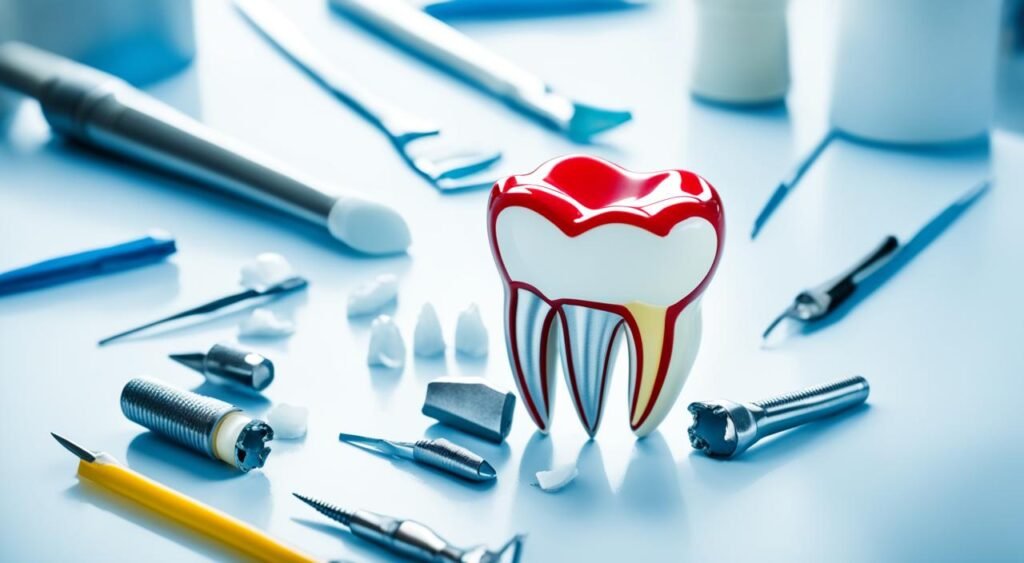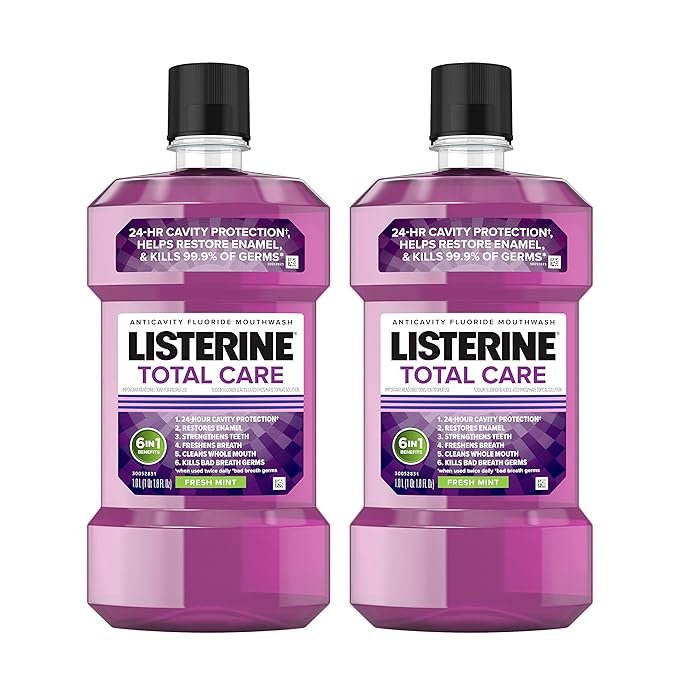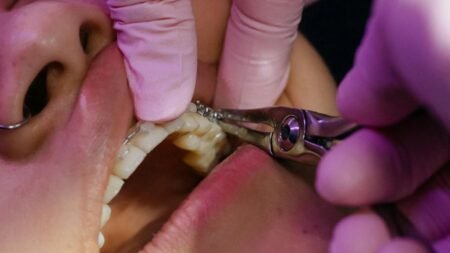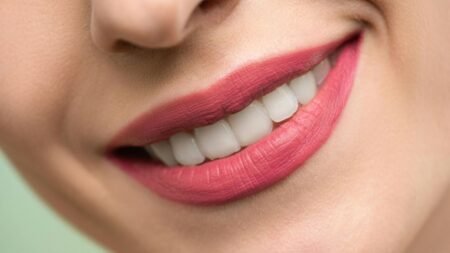Are you looking for ways to keep your teeth strong and cavity-free without going to the dentist often? You can do DIY fluoride treatment at home. Using fluoride toothpaste and mouthwash daily can help prevent cavities and strengthen your teeth.
Fluoride is key in making your teeth strong against decay. Even if your water has fluoride, adding more at home can help. Products like toothpaste and mouthwash have fluoride levels from 0.05% to 0.12%. Prescription options have even more for extra protection.
Adding fluoride to your daily routine can protect your teeth and keep your smile bright. Whether you choose over-the-counter or prescription options, DIY fluoride treatments are easy and save money. They help keep your teeth strong and free from cavities.
Key Takeaways
- Fluoride is essential for strengthening teeth and preventing cavities
- DIY fluoride treatments can be performed at home using fluoride toothpaste and mouthwash
- Over-the-counter fluoride products contain concentrations ranging from 0.05% to 0.12% sodium fluoride
- Prescription fluoride treatments offer higher concentrations for those who need extra protection
- At-home fluoride treatments are convenient, cost-effective, and can help maintain a healthy smile
The Importance of Fluoride in Dental Health
Fluoride is a key mineral for good dental health. It’s found in some foods and water and added to toothpaste and mouthwash. Fluoride stops tooth decay, makes enamel stronger, and helps teeth remineralize. It’s crucial for keeping teeth healthy.
Understanding Tooth Remineralization and Decay Prevention
Tooth remineralization is when minerals like calcium and phosphate go back into tooth enamel after acid loss. Fluoride helps by bringing these minerals to the tooth and making them part of the enamel. This stops tooth decay and cavities.
Tooth decay happens when mouth bacteria eat sugars and starches, making acid. This acid eats away at the enamel, causing cavities. Fluoride fights this by making enamel stronger against acid.

The Role of Fluoride in Strengthening Tooth Enamel
Tooth enamel is the hard outer layer of the tooth. It’s made of minerals like calcium and phosphate. Fluoride works with these minerals to create fluorapatite, a stronger enamel type. This makes teeth less likely to decay.
| Mineral | Role in Tooth Enamel |
|---|---|
| Calcium | Primary component of tooth enamel, provides strength and structure |
| Phosphate | Combines with calcium to form hydroxyapatite, the main mineral in tooth enamel |
| Fluoride | Interacts with calcium and phosphate to form fluorapatite, strengthening tooth enamel and increasing acid resistance |
Public Health Perspectives on Fluoridation
Fluoridating public water has greatly helped prevent tooth decay. About 62% of Americans get fluoridated water, and 43 big U.S. cities have programs for it.
The Centers for Disease Control and Prevention (CDC) has recognized water fluoridation as one of the ten great public health achievements of the 20th century.
Studies show fluoridated water cuts cavities in kids by up to 300%. This shows fluoride’s big impact on public health, making teeth healthier for everyone.
Fluoride Treatment at Home: Getting Started
Starting a home fluoride treatment is easy and helps protect your teeth. Use fluoride toothpaste twice a day, found in most drugstores and supermarkets. Choose toothpaste with at least 1000 parts per million (ppm) fluoride for best protection.

For more fluoride, try fluoride mouthwash or rinse once or twice a day. Use a mouthwash with about 0.05% fluoride. Always follow the product label and don’t swallow the mouthwash.
“Fluoride treatments at home are stated to be as effective as in-office treatments, with added convenience and cost savings.”
If you’re at high risk for cavities, your dentist might suggest stronger fluoride products. These include:
- Prevident toothpaste and mouth rinses
- Clinpro 5000 toothpaste, with more fluoride and Tri-Calcium Phosphate
- MI PastePlus, which also helps remineralize teeth
Use these prescription fluoride treatments with your regular dental care for best results. Always follow your dentist’s advice when using these products.
| Product | Fluoride Content | Recommended Use |
|---|---|---|
| Fluoride Toothpaste | At least 1000 ppm | Twice daily |
| Fluoride Mouthwash | Around 0.05% | Once or twice daily |
| Prescription Fluoride Products | Higher concentrations | As directed by dentist |
Using fluoride toothpaste, mouthwash, and prescription treatments helps protect your teeth. This way, you can keep your mouth healthy from home.
DIY Fluoride Application: Products and Techniques
Protecting your teeth at home is key to preventing tooth decay and keeping your mouth healthy. Using fluoride products daily can strengthen your teeth and lower cavity risk. Let’s look at how you can apply fluoride at home.
Choosing the Right Fluoride Toothpaste for Daily Use
Fluoride toothpaste is a top choice for daily fluoride use. When picking a toothpaste, aim for products with 1,000 to 1,500 parts per million (ppm) of fluoride. The American Dental Association (ADA) seal means it’s safe and effective.
Over 95% of toothpaste sales in the U.S. are fluoride toothpastes, showing how widely accepted fluoride is for dental care.
To get the most from fluoride toothpaste, use a pea-sized amount and brush for two minutes, twice a day. Make sure to brush all teeth surfaces for even fluoride coverage.

Listerine Total Care Anticavity Fluoride Mouthwash, Fresh Mint Flavor: Eliminates 99.9% of Germs That Cause Bad Breath and Prevents Cavities.
Integrating Fluoride Mouthwash into Your Oral Care Routine
Fluoride mouthwash is another way to boost your daily fluoride intake. Look for mouthwashes with about 0.05% fluoride for the best dental benefits.
Here’s how to use fluoride mouthwash:
- Brush and floss your teeth as usual.
- Measure the recommended mouthwash amount, about 20ml or 2/3 fluid ounce.
- Swish the mouthwash in your mouth for 30 seconds to 1 minute, covering all teeth and gums.
- Spit out the mouthwash and wait at least 30 minutes before eating or drinking.
Fluoride mouthwash is safe for people over six years old. Always follow the product label and talk to your dentist if you have questions.
Understanding Prescription Fluoride Treatments
Your dentist might suggest prescription fluoride treatments if you’re at high risk for cavities or have dental problems. These treatments have more fluoride than what you can buy over the counter. They’re made to protect and strengthen your teeth.
| Prescription Fluoride Product | Fluoride Concentration | Recommended Usage |
|---|---|---|
| Prevident 5000 Plus | 1.1% Sodium Fluoride (5,000 ppm) | Apply a thin ribbon to teeth before bedtime, after brushing. Spit out excess. |
| Clinpro 5000 | 1.1% Sodium Fluoride (5,000 ppm) | Apply a thin ribbon to teeth before bedtime, after brushing. Spit out excess. |
| MI Paste Plus | 0.2% Sodium Fluoride (900 ppm) | Apply a pea-sized amount to teeth after brushing, leave on for 3 minutes, then spit out excess. |
Prescription fluoride treatments can be toothpaste, gels, or varnishes. Your dentist will tell you how to use them safely and effectively. It’s important to follow their advice to avoid side effects like dental fluorosis.
Using fluoride products and techniques daily can help protect your teeth from decay. Always talk to your dentist to make sure you’re using the right products and methods for your dental health.
Caring for Your Family’s Teeth: Age-Specific Recommendations
Understanding the unique needs of each age group is key to proper family dental care. Tailoring your approach to oral hygiene based on age can help keep your loved ones’ teeth healthy. Let’s look at the best ways to care for children’s teeth and guide teenagers and adults in using fluoride at home.
Fluoride Treatments for Children: Safety and Dosage
Fluoride is crucial for kids’ dental health, preventing cavities and building strong teeth. But, it’s important to use it safely and correctly:
- Children under 2 should not use fluoride toothpaste or mouthwash. Talk to your dentist about an oral fluoride supplement instead.
- Kids between 2 and 6 can use a pea-sized amount of toothpaste with fluoride. Make sure to watch them while they brush to stop them from swallowing.
- Don’t give fluoride rinses to kids under 6 because they might swallow it.
- A dental professional can apply fluoride varnishes, gels, or foams every 3 to 6 months starting when the first tooth comes in.
Guiding Teenagers and Adults in Fluoride Use at Home
As kids grow into teenagers and adults, their fluoride needs change. Here are some tips for keeping your mouth healthy with fluoride:
- Brush your teeth twice a day with fluoride toothpaste that has at least 1350ppm of fluoride.
- Add a fluoride mouthwash to your daily routine, using it once a day after brushing and flossing.
- Choose specialized toothpastes, like tartar control or sensitivity formulas, based on what you need.
- Go to the dentist regularly for check-ups and cleanings. This lets your dentist check your mouth health and give you professional fluoride treatments if needed.
The American Dental Association says everyone should brush their teeth twice a day with fluoride toothpaste and see a dentist regularly for the best mouth health.
| Age Group | Fluoride Toothpaste | Fluoride Mouthwash | Professional Treatments |
|---|---|---|---|
| Under 2 years | Not recommended | Not recommended | Oral fluoride supplement (prescribed) |
| 2-6 years | Pea-sized amount (1000ppm+) | Not recommended | Fluoridated varnishes, gels, or foams every 3-6 months |
| 6+ years | Regular use (1350ppm+) | Once daily | As recommended by dentist |
Following these fluoride use tips for different ages can help your family keep their teeth healthy and avoid cavities. Always watch over young kids when they use fluoride products and talk to your dentist if you have any questions about caring for your family’s teeth.
Conclusion
Using fluoride treatments daily helps keep your smile healthy and stops cavities. Adults and kids over six should use toothpaste with 1,350 ppm of fluoride. Mouthwash with 0.05% sodium fluoride also helps. For extra protection, your dentist might suggest stronger fluoride treatments.
It’s important to follow guidelines for fluoride use based on your age. Kids and teens get a lot of benefit from fluoride during their teeth growth. Studies show a 12% less chance of cavities in kids who use fluoride varnish.
But, watch out for young kids to avoid too much fluoride, which can cause fluorosis. Adults with cavity history can also use fluoride treatments to prevent more cavities.
At-home fluoride treatments work well, but don’t forget regular dental check-ups and professional fluoride treatments. Your dentist might suggest dental sealants for extra protection. Good oral hygiene, like brushing twice a day, and a healthy diet, also help keep your mouth healthy. With a full dental care plan, your smile can stay healthy and cavity-free.
FAQ
What is the importance of fluoride in dental health?
Fluoride is key for dental health. It prevents tooth decay, strengthens tooth enamel, and helps teeth remineralize. This process keeps teeth strong and healthy.
How can I start a fluoride treatment at home?
Start with fluoride toothpaste twice a day. You can also use fluoride mouthwash once or twice a day. This gives your teeth an extra fluoride boost.
What should I look for when choosing a fluoride toothpaste for daily use?
Choose toothpaste with 0.05% to 0.12% sodium fluoride. Use a pea-sized amount and brush for two minutes twice a day.
How can I integrate fluoride mouthwash into my oral care routine?
Add fluoride mouthwash once a day to your routine. Brush and floss first. Wait 30 minutes before eating or drinking to let the fluoride work.
What are prescription fluoride treatments, and how do they differ from over-the-counter products?
Prescription fluoride treatments have more fluoride and may include minerals like tri-calcium phosphate or Recaldent. They help teeth remineralize and reverse decay. Dentists prescribe them for those at high risk of cavities.
When should children start receiving fluoride treatments?
Start fluoride treatments when the first baby tooth comes in. Kids under two should use fluoride supplements, not toothpaste or mouthwash. The ADA says kids under two shouldn’t use fluoride toothpaste or mouthwash to avoid swallowing it.
Can at-home fluoride treatments replace regular dental check-ups and professional fluoride applications?
At-home fluoride treatments help, but they shouldn’t replace dental check-ups and professional fluoride. Good oral hygiene, a balanced diet, and regular dental visits keep teeth healthy for life.








